LIDL Industry Marketing Report: Market Analysis and Strategies
VerifiedAdded on 2020/07/22
|22
|6469
|640
Report
AI Summary
This report provides a comprehensive marketing analysis of the LIDL industry within the UK grocery retail market. It begins with an introduction to the market, highlighting key trends and Lidl's position. The report then delves into a detailed analysis, encompassing a SWOT analysis of Lidl, a PESTLE analysis to understand the external factors affecting the firm, and a competitor matrix to assess its competitive landscape. The report further utilizes the BCG matrix and Ansoff's matrix to evaluate strategic options for growth and market expansion. It examines the potential of various market segments to drive consumer yield and discusses marketing strategies, including the 7Ps marketing mix model. The report concludes with recommendations to address challenges and risks, offering a holistic view of Lidl's market position and future prospects. The analysis covers the market share of grocers in Great Britain, the impact of economic recession and inflation, and the rise of discounters like Aldi and Lidl. The report also discusses the potential of a joint venture between Lidl and Tesco and covers political, economic, social, technological, legal, and environmental factors affecting Lidl's operations. The report analyzes the competitive advantages of Lidl, the growth matrix, and the application of Ansoff's matrix for market penetration, product development, and market development.
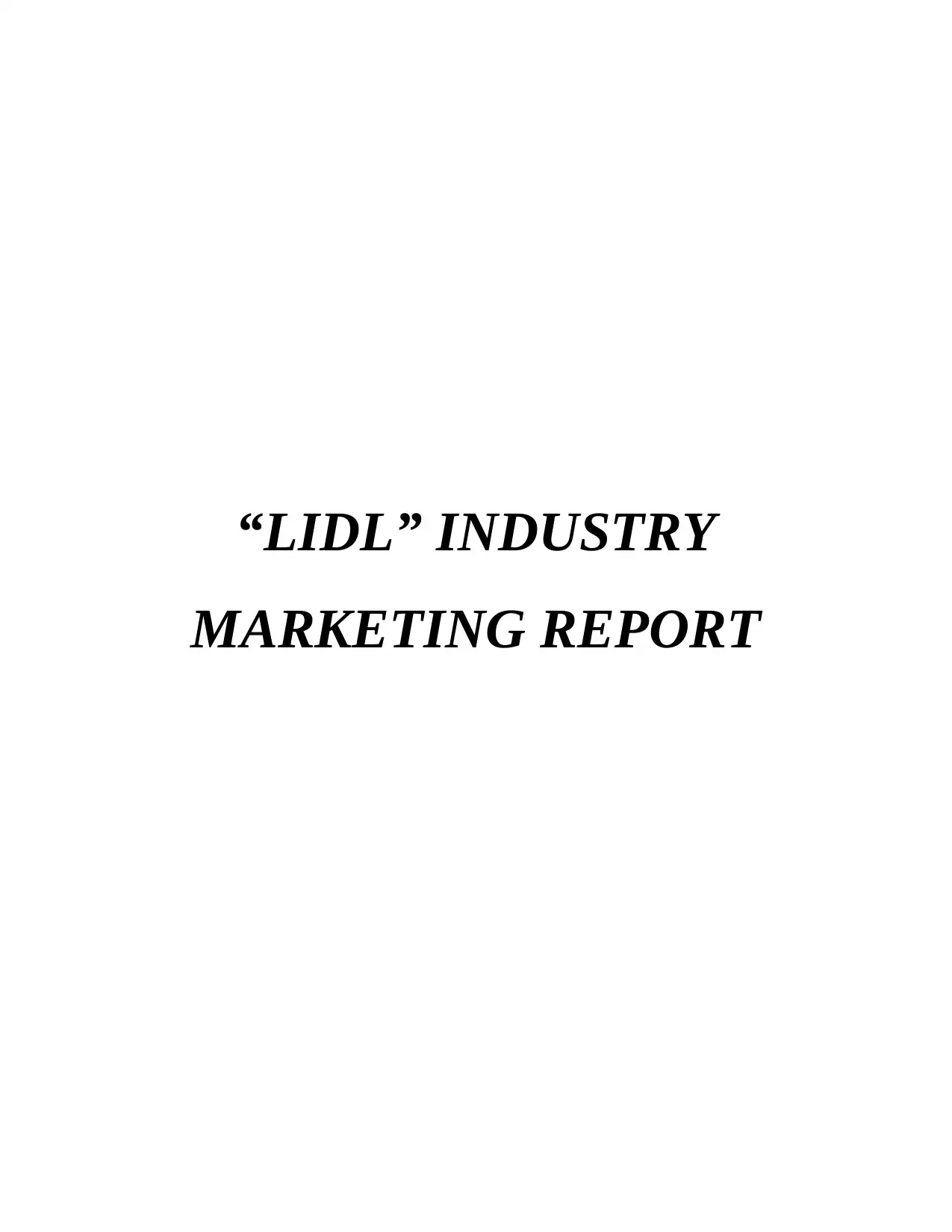
“LIDL” INDUSTRY
MARKETING REPORT
MARKETING REPORT
Paraphrase This Document
Need a fresh take? Get an instant paraphrase of this document with our AI Paraphraser
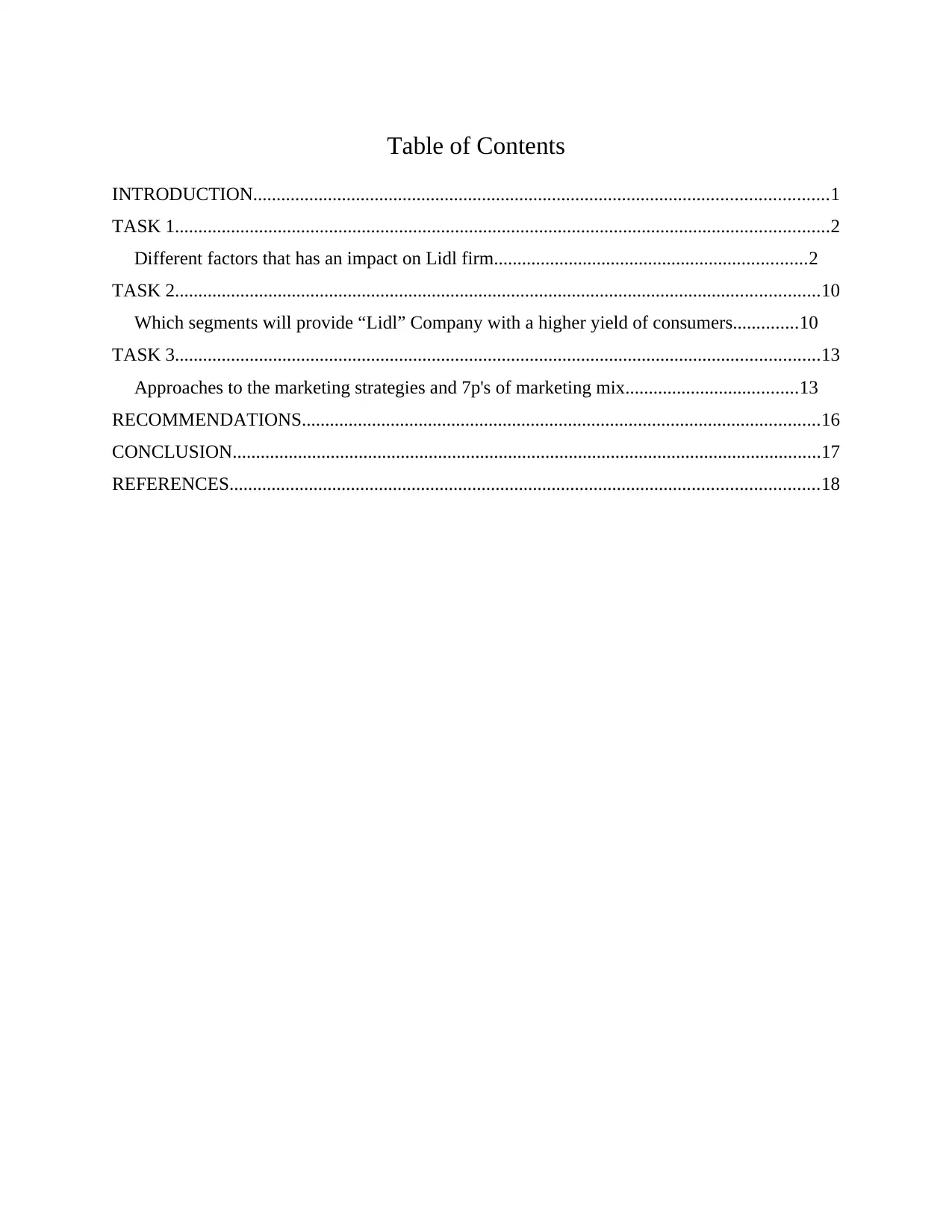
Table of Contents
INTRODUCTION...........................................................................................................................1
TASK 1............................................................................................................................................2
Different factors that has an impact on Lidl firm...................................................................2
TASK 2..........................................................................................................................................10
Which segments will provide “Lidl” Company with a higher yield of consumers..............10
TASK 3..........................................................................................................................................13
Approaches to the marketing strategies and 7p's of marketing mix.....................................13
RECOMMENDATIONS...............................................................................................................16
CONCLUSION..............................................................................................................................17
REFERENCES..............................................................................................................................18
INTRODUCTION...........................................................................................................................1
TASK 1............................................................................................................................................2
Different factors that has an impact on Lidl firm...................................................................2
TASK 2..........................................................................................................................................10
Which segments will provide “Lidl” Company with a higher yield of consumers..............10
TASK 3..........................................................................................................................................13
Approaches to the marketing strategies and 7p's of marketing mix.....................................13
RECOMMENDATIONS...............................................................................................................16
CONCLUSION..............................................................................................................................17
REFERENCES..............................................................................................................................18
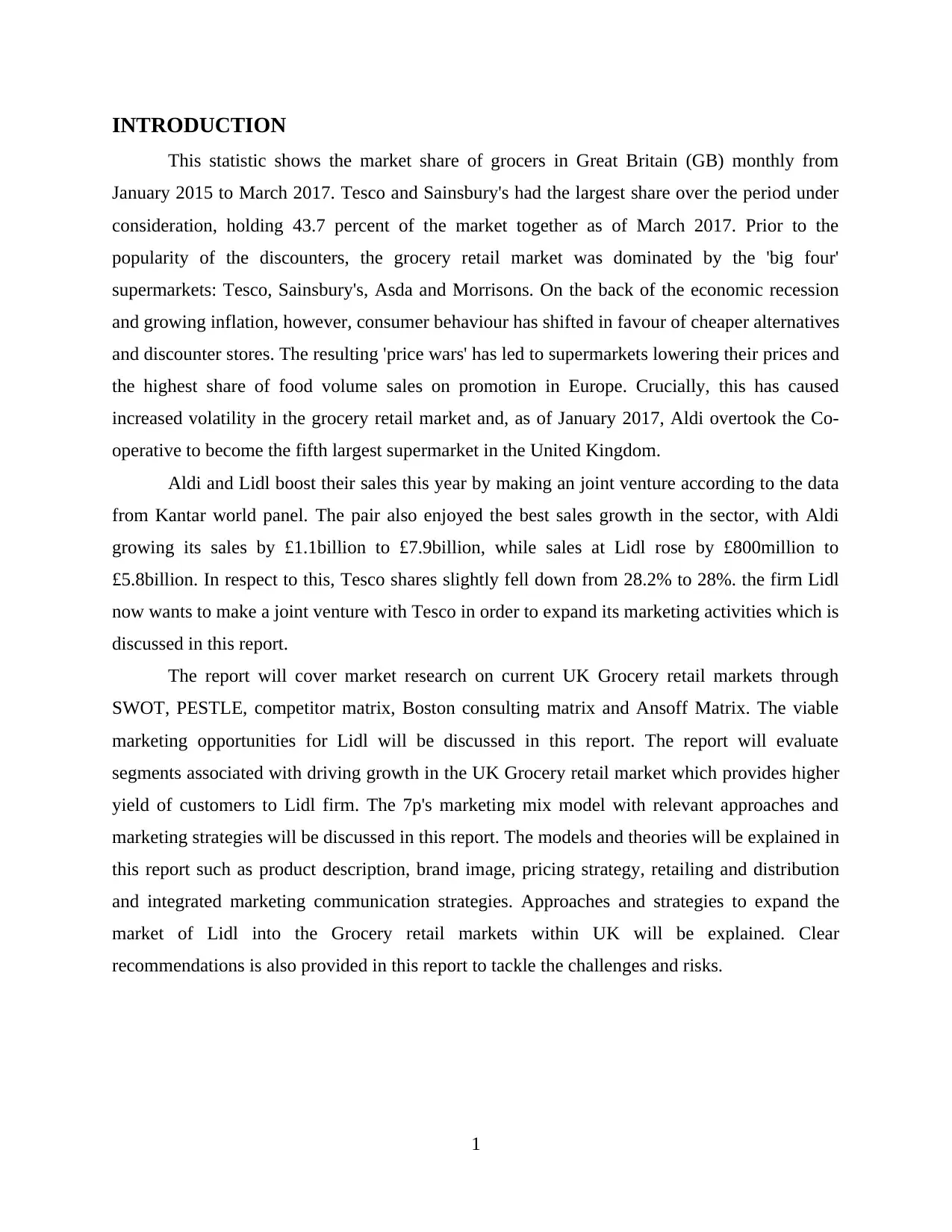
INTRODUCTION
This statistic shows the market share of grocers in Great Britain (GB) monthly from
January 2015 to March 2017. Tesco and Sainsbury's had the largest share over the period under
consideration, holding 43.7 percent of the market together as of March 2017. Prior to the
popularity of the discounters, the grocery retail market was dominated by the 'big four'
supermarkets: Tesco, Sainsbury's, Asda and Morrisons. On the back of the economic recession
and growing inflation, however, consumer behaviour has shifted in favour of cheaper alternatives
and discounter stores. The resulting 'price wars' has led to supermarkets lowering their prices and
the highest share of food volume sales on promotion in Europe. Crucially, this has caused
increased volatility in the grocery retail market and, as of January 2017, Aldi overtook the Co-
operative to become the fifth largest supermarket in the United Kingdom.
Aldi and Lidl boost their sales this year by making an joint venture according to the data
from Kantar world panel. The pair also enjoyed the best sales growth in the sector, with Aldi
growing its sales by £1.1billion to £7.9billion, while sales at Lidl rose by £800million to
£5.8billion. In respect to this, Tesco shares slightly fell down from 28.2% to 28%. the firm Lidl
now wants to make a joint venture with Tesco in order to expand its marketing activities which is
discussed in this report.
The report will cover market research on current UK Grocery retail markets through
SWOT, PESTLE, competitor matrix, Boston consulting matrix and Ansoff Matrix. The viable
marketing opportunities for Lidl will be discussed in this report. The report will evaluate
segments associated with driving growth in the UK Grocery retail market which provides higher
yield of customers to Lidl firm. The 7p's marketing mix model with relevant approaches and
marketing strategies will be discussed in this report. The models and theories will be explained in
this report such as product description, brand image, pricing strategy, retailing and distribution
and integrated marketing communication strategies. Approaches and strategies to expand the
market of Lidl into the Grocery retail markets within UK will be explained. Clear
recommendations is also provided in this report to tackle the challenges and risks.
1
This statistic shows the market share of grocers in Great Britain (GB) monthly from
January 2015 to March 2017. Tesco and Sainsbury's had the largest share over the period under
consideration, holding 43.7 percent of the market together as of March 2017. Prior to the
popularity of the discounters, the grocery retail market was dominated by the 'big four'
supermarkets: Tesco, Sainsbury's, Asda and Morrisons. On the back of the economic recession
and growing inflation, however, consumer behaviour has shifted in favour of cheaper alternatives
and discounter stores. The resulting 'price wars' has led to supermarkets lowering their prices and
the highest share of food volume sales on promotion in Europe. Crucially, this has caused
increased volatility in the grocery retail market and, as of January 2017, Aldi overtook the Co-
operative to become the fifth largest supermarket in the United Kingdom.
Aldi and Lidl boost their sales this year by making an joint venture according to the data
from Kantar world panel. The pair also enjoyed the best sales growth in the sector, with Aldi
growing its sales by £1.1billion to £7.9billion, while sales at Lidl rose by £800million to
£5.8billion. In respect to this, Tesco shares slightly fell down from 28.2% to 28%. the firm Lidl
now wants to make a joint venture with Tesco in order to expand its marketing activities which is
discussed in this report.
The report will cover market research on current UK Grocery retail markets through
SWOT, PESTLE, competitor matrix, Boston consulting matrix and Ansoff Matrix. The viable
marketing opportunities for Lidl will be discussed in this report. The report will evaluate
segments associated with driving growth in the UK Grocery retail market which provides higher
yield of customers to Lidl firm. The 7p's marketing mix model with relevant approaches and
marketing strategies will be discussed in this report. The models and theories will be explained in
this report such as product description, brand image, pricing strategy, retailing and distribution
and integrated marketing communication strategies. Approaches and strategies to expand the
market of Lidl into the Grocery retail markets within UK will be explained. Clear
recommendations is also provided in this report to tackle the challenges and risks.
1
⊘ This is a preview!⊘
Do you want full access?
Subscribe today to unlock all pages.

Trusted by 1+ million students worldwide
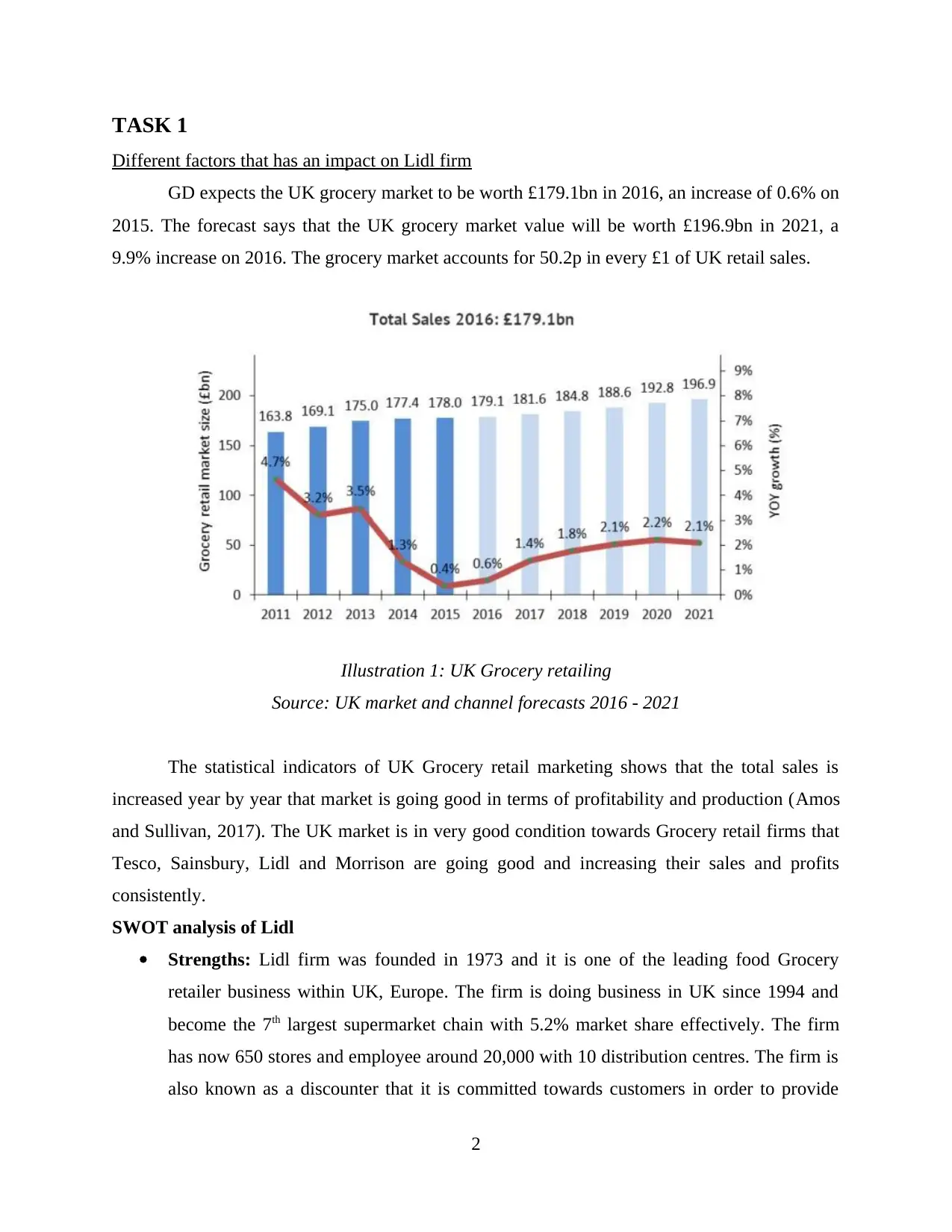
TASK 1
Different factors that has an impact on Lidl firm
GD expects the UK grocery market to be worth £179.1bn in 2016, an increase of 0.6% on
2015. The forecast says that the UK grocery market value will be worth £196.9bn in 2021, a
9.9% increase on 2016. The grocery market accounts for 50.2p in every £1 of UK retail sales.
The statistical indicators of UK Grocery retail marketing shows that the total sales is
increased year by year that market is going good in terms of profitability and production (Amos
and Sullivan, 2017). The UK market is in very good condition towards Grocery retail firms that
Tesco, Sainsbury, Lidl and Morrison are going good and increasing their sales and profits
consistently.
SWOT analysis of Lidl
Strengths: Lidl firm was founded in 1973 and it is one of the leading food Grocery
retailer business within UK, Europe. The firm is doing business in UK since 1994 and
become the 7th largest supermarket chain with 5.2% market share effectively. The firm
has now 650 stores and employee around 20,000 with 10 distribution centres. The firm is
also known as a discounter that it is committed towards customers in order to provide
2
Illustration 1: UK Grocery retailing
Source: UK market and channel forecasts 2016 - 2021
Different factors that has an impact on Lidl firm
GD expects the UK grocery market to be worth £179.1bn in 2016, an increase of 0.6% on
2015. The forecast says that the UK grocery market value will be worth £196.9bn in 2021, a
9.9% increase on 2016. The grocery market accounts for 50.2p in every £1 of UK retail sales.
The statistical indicators of UK Grocery retail marketing shows that the total sales is
increased year by year that market is going good in terms of profitability and production (Amos
and Sullivan, 2017). The UK market is in very good condition towards Grocery retail firms that
Tesco, Sainsbury, Lidl and Morrison are going good and increasing their sales and profits
consistently.
SWOT analysis of Lidl
Strengths: Lidl firm was founded in 1973 and it is one of the leading food Grocery
retailer business within UK, Europe. The firm is doing business in UK since 1994 and
become the 7th largest supermarket chain with 5.2% market share effectively. The firm
has now 650 stores and employee around 20,000 with 10 distribution centres. The firm is
also known as a discounter that it is committed towards customers in order to provide
2
Illustration 1: UK Grocery retailing
Source: UK market and channel forecasts 2016 - 2021
Paraphrase This Document
Need a fresh take? Get an instant paraphrase of this document with our AI Paraphraser
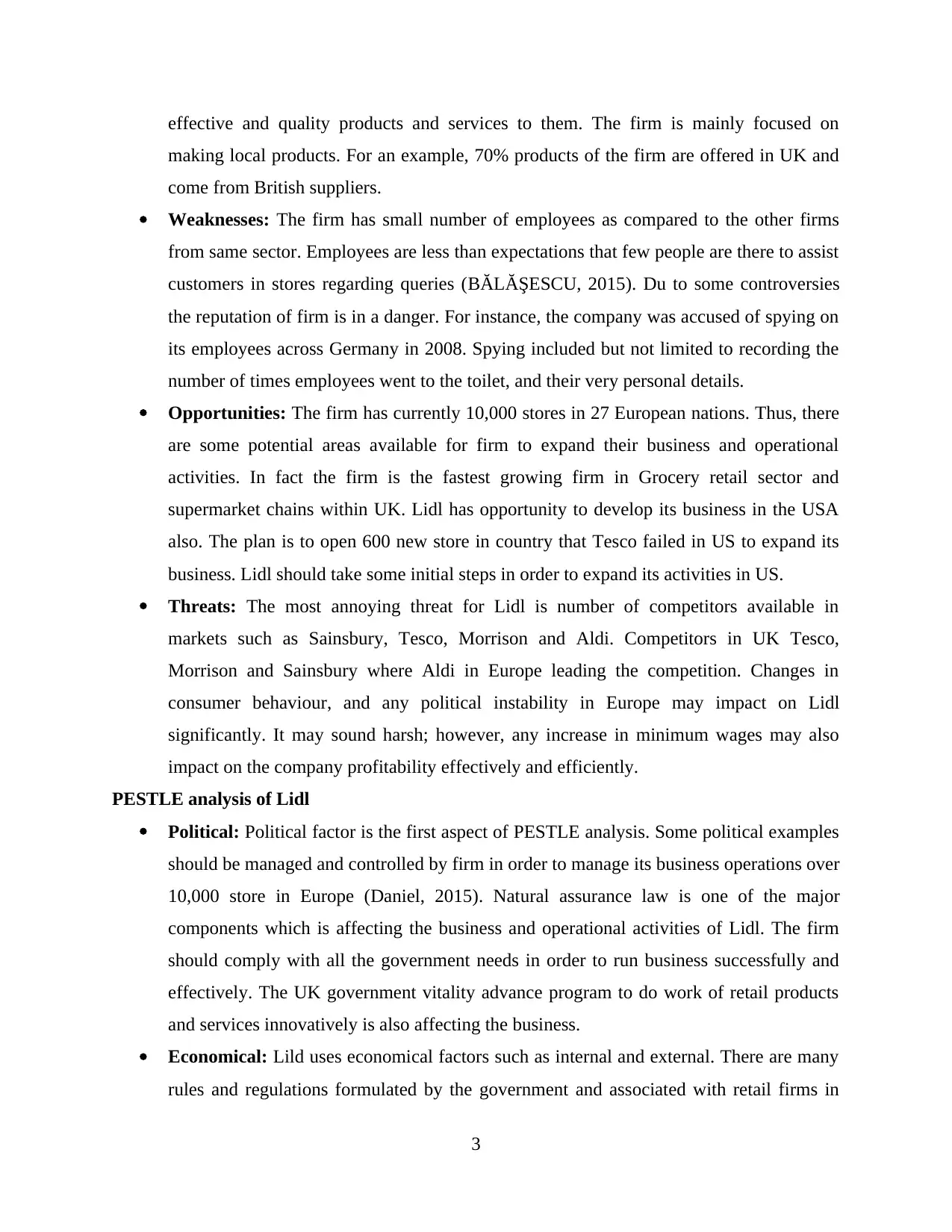
effective and quality products and services to them. The firm is mainly focused on
making local products. For an example, 70% products of the firm are offered in UK and
come from British suppliers.
Weaknesses: The firm has small number of employees as compared to the other firms
from same sector. Employees are less than expectations that few people are there to assist
customers in stores regarding queries (BĂLĂŞESCU, 2015). Du to some controversies
the reputation of firm is in a danger. For instance, the company was accused of spying on
its employees across Germany in 2008. Spying included but not limited to recording the
number of times employees went to the toilet, and their very personal details.
Opportunities: The firm has currently 10,000 stores in 27 European nations. Thus, there
are some potential areas available for firm to expand their business and operational
activities. In fact the firm is the fastest growing firm in Grocery retail sector and
supermarket chains within UK. Lidl has opportunity to develop its business in the USA
also. The plan is to open 600 new store in country that Tesco failed in US to expand its
business. Lidl should take some initial steps in order to expand its activities in US.
Threats: The most annoying threat for Lidl is number of competitors available in
markets such as Sainsbury, Tesco, Morrison and Aldi. Competitors in UK Tesco,
Morrison and Sainsbury where Aldi in Europe leading the competition. Changes in
consumer behaviour, and any political instability in Europe may impact on Lidl
significantly. It may sound harsh; however, any increase in minimum wages may also
impact on the company profitability effectively and efficiently.
PESTLE analysis of Lidl
Political: Political factor is the first aspect of PESTLE analysis. Some political examples
should be managed and controlled by firm in order to manage its business operations over
10,000 store in Europe (Daniel, 2015). Natural assurance law is one of the major
components which is affecting the business and operational activities of Lidl. The firm
should comply with all the government needs in order to run business successfully and
effectively. The UK government vitality advance program to do work of retail products
and services innovatively is also affecting the business.
Economical: Lild uses economical factors such as internal and external. There are many
rules and regulations formulated by the government and associated with retail firms in
3
making local products. For an example, 70% products of the firm are offered in UK and
come from British suppliers.
Weaknesses: The firm has small number of employees as compared to the other firms
from same sector. Employees are less than expectations that few people are there to assist
customers in stores regarding queries (BĂLĂŞESCU, 2015). Du to some controversies
the reputation of firm is in a danger. For instance, the company was accused of spying on
its employees across Germany in 2008. Spying included but not limited to recording the
number of times employees went to the toilet, and their very personal details.
Opportunities: The firm has currently 10,000 stores in 27 European nations. Thus, there
are some potential areas available for firm to expand their business and operational
activities. In fact the firm is the fastest growing firm in Grocery retail sector and
supermarket chains within UK. Lidl has opportunity to develop its business in the USA
also. The plan is to open 600 new store in country that Tesco failed in US to expand its
business. Lidl should take some initial steps in order to expand its activities in US.
Threats: The most annoying threat for Lidl is number of competitors available in
markets such as Sainsbury, Tesco, Morrison and Aldi. Competitors in UK Tesco,
Morrison and Sainsbury where Aldi in Europe leading the competition. Changes in
consumer behaviour, and any political instability in Europe may impact on Lidl
significantly. It may sound harsh; however, any increase in minimum wages may also
impact on the company profitability effectively and efficiently.
PESTLE analysis of Lidl
Political: Political factor is the first aspect of PESTLE analysis. Some political examples
should be managed and controlled by firm in order to manage its business operations over
10,000 store in Europe (Daniel, 2015). Natural assurance law is one of the major
components which is affecting the business and operational activities of Lidl. The firm
should comply with all the government needs in order to run business successfully and
effectively. The UK government vitality advance program to do work of retail products
and services innovatively is also affecting the business.
Economical: Lild uses economical factors such as internal and external. There are many
rules and regulations formulated by the government and associated with retail firms in
3
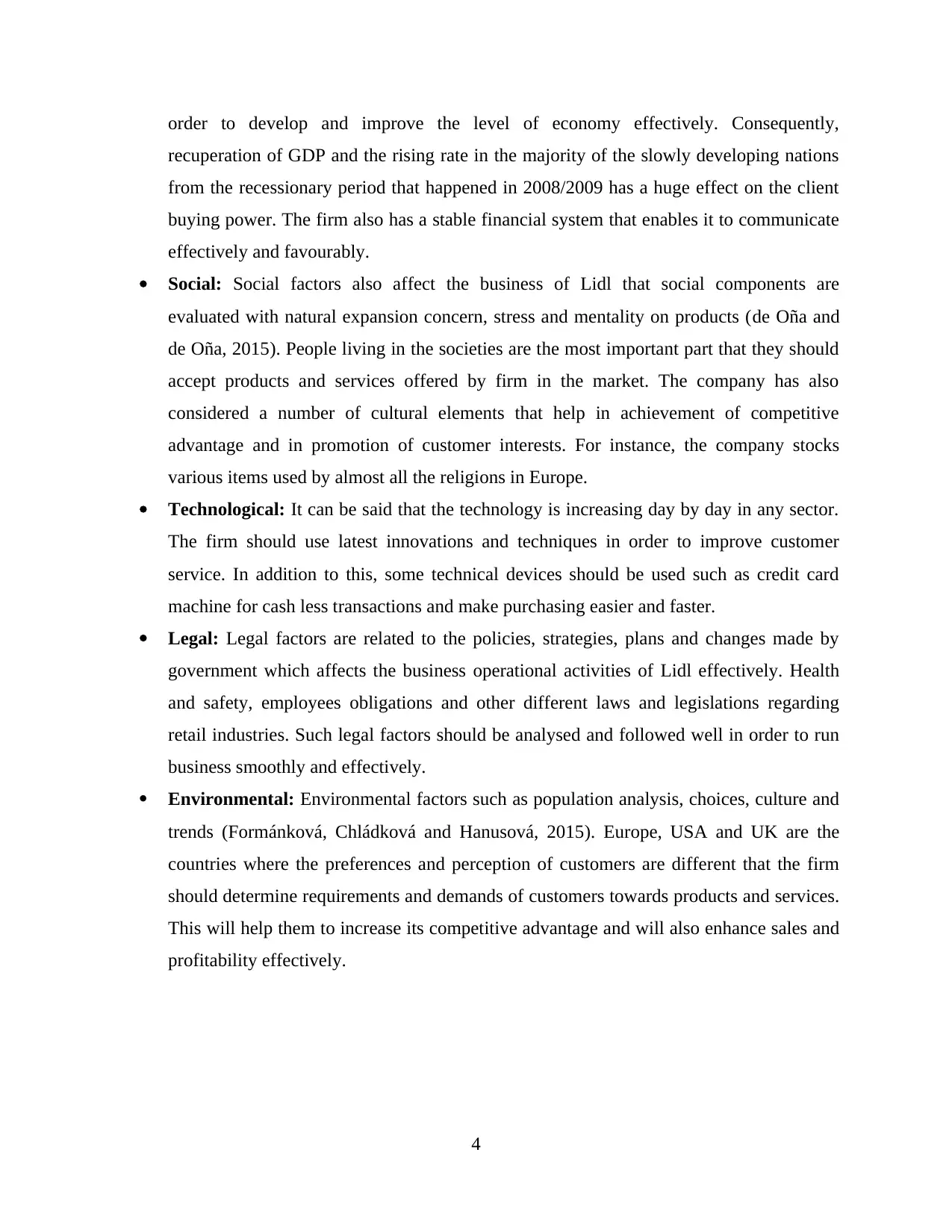
order to develop and improve the level of economy effectively. Consequently,
recuperation of GDP and the rising rate in the majority of the slowly developing nations
from the recessionary period that happened in 2008/2009 has a huge effect on the client
buying power. The firm also has a stable financial system that enables it to communicate
effectively and favourably.
Social: Social factors also affect the business of Lidl that social components are
evaluated with natural expansion concern, stress and mentality on products (de Oña and
de Oña, 2015). People living in the societies are the most important part that they should
accept products and services offered by firm in the market. The company has also
considered a number of cultural elements that help in achievement of competitive
advantage and in promotion of customer interests. For instance, the company stocks
various items used by almost all the religions in Europe.
Technological: It can be said that the technology is increasing day by day in any sector.
The firm should use latest innovations and techniques in order to improve customer
service. In addition to this, some technical devices should be used such as credit card
machine for cash less transactions and make purchasing easier and faster.
Legal: Legal factors are related to the policies, strategies, plans and changes made by
government which affects the business operational activities of Lidl effectively. Health
and safety, employees obligations and other different laws and legislations regarding
retail industries. Such legal factors should be analysed and followed well in order to run
business smoothly and effectively.
Environmental: Environmental factors such as population analysis, choices, culture and
trends (Formánková, Chládková and Hanusová, 2015). Europe, USA and UK are the
countries where the preferences and perception of customers are different that the firm
should determine requirements and demands of customers towards products and services.
This will help them to increase its competitive advantage and will also enhance sales and
profitability effectively.
4
recuperation of GDP and the rising rate in the majority of the slowly developing nations
from the recessionary period that happened in 2008/2009 has a huge effect on the client
buying power. The firm also has a stable financial system that enables it to communicate
effectively and favourably.
Social: Social factors also affect the business of Lidl that social components are
evaluated with natural expansion concern, stress and mentality on products (de Oña and
de Oña, 2015). People living in the societies are the most important part that they should
accept products and services offered by firm in the market. The company has also
considered a number of cultural elements that help in achievement of competitive
advantage and in promotion of customer interests. For instance, the company stocks
various items used by almost all the religions in Europe.
Technological: It can be said that the technology is increasing day by day in any sector.
The firm should use latest innovations and techniques in order to improve customer
service. In addition to this, some technical devices should be used such as credit card
machine for cash less transactions and make purchasing easier and faster.
Legal: Legal factors are related to the policies, strategies, plans and changes made by
government which affects the business operational activities of Lidl effectively. Health
and safety, employees obligations and other different laws and legislations regarding
retail industries. Such legal factors should be analysed and followed well in order to run
business smoothly and effectively.
Environmental: Environmental factors such as population analysis, choices, culture and
trends (Formánková, Chládková and Hanusová, 2015). Europe, USA and UK are the
countries where the preferences and perception of customers are different that the firm
should determine requirements and demands of customers towards products and services.
This will help them to increase its competitive advantage and will also enhance sales and
profitability effectively.
4
⊘ This is a preview!⊘
Do you want full access?
Subscribe today to unlock all pages.

Trusted by 1+ million students worldwide
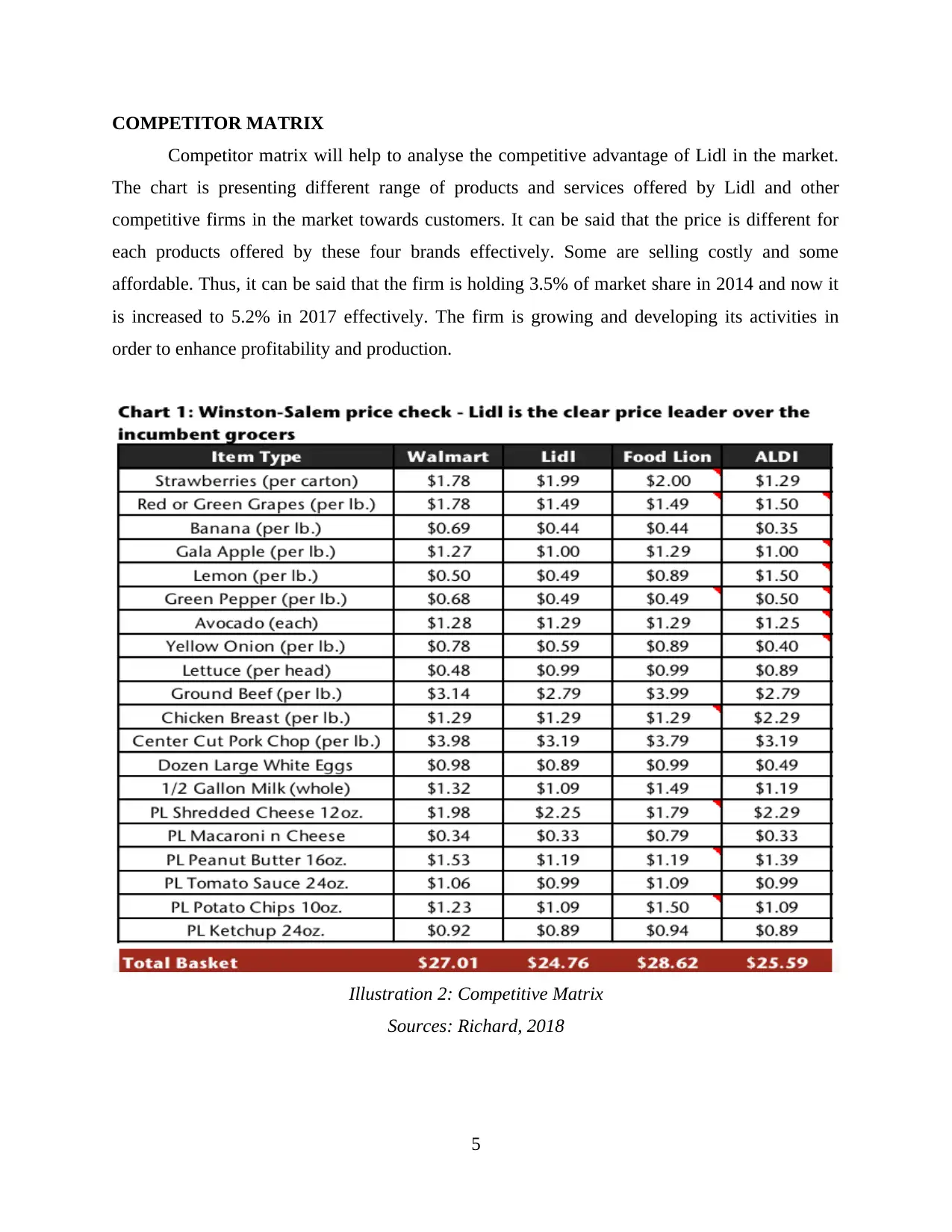
COMPETITOR MATRIX
Competitor matrix will help to analyse the competitive advantage of Lidl in the market.
The chart is presenting different range of products and services offered by Lidl and other
competitive firms in the market towards customers. It can be said that the price is different for
each products offered by these four brands effectively. Some are selling costly and some
affordable. Thus, it can be said that the firm is holding 3.5% of market share in 2014 and now it
is increased to 5.2% in 2017 effectively. The firm is growing and developing its activities in
order to enhance profitability and production.
5
Illustration 2: Competitive Matrix
Sources: Richard, 2018
Competitor matrix will help to analyse the competitive advantage of Lidl in the market.
The chart is presenting different range of products and services offered by Lidl and other
competitive firms in the market towards customers. It can be said that the price is different for
each products offered by these four brands effectively. Some are selling costly and some
affordable. Thus, it can be said that the firm is holding 3.5% of market share in 2014 and now it
is increased to 5.2% in 2017 effectively. The firm is growing and developing its activities in
order to enhance profitability and production.
5
Illustration 2: Competitive Matrix
Sources: Richard, 2018
Paraphrase This Document
Need a fresh take? Get an instant paraphrase of this document with our AI Paraphraser
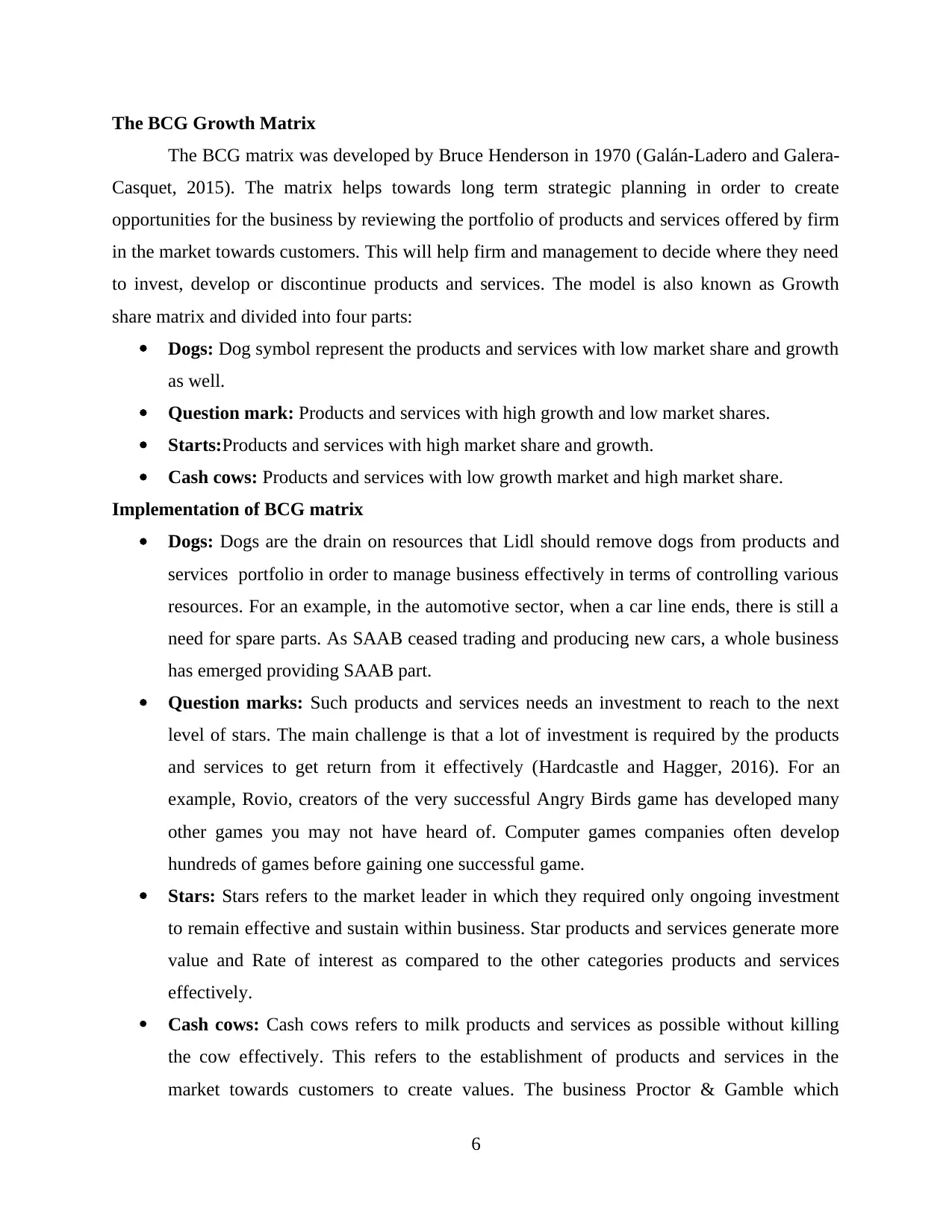
The BCG Growth Matrix
The BCG matrix was developed by Bruce Henderson in 1970 (Galán-Ladero and Galera-
Casquet, 2015). The matrix helps towards long term strategic planning in order to create
opportunities for the business by reviewing the portfolio of products and services offered by firm
in the market towards customers. This will help firm and management to decide where they need
to invest, develop or discontinue products and services. The model is also known as Growth
share matrix and divided into four parts:
Dogs: Dog symbol represent the products and services with low market share and growth
as well.
Question mark: Products and services with high growth and low market shares.
Starts:Products and services with high market share and growth.
Cash cows: Products and services with low growth market and high market share.
Implementation of BCG matrix
Dogs: Dogs are the drain on resources that Lidl should remove dogs from products and
services portfolio in order to manage business effectively in terms of controlling various
resources. For an example, in the automotive sector, when a car line ends, there is still a
need for spare parts. As SAAB ceased trading and producing new cars, a whole business
has emerged providing SAAB part.
Question marks: Such products and services needs an investment to reach to the next
level of stars. The main challenge is that a lot of investment is required by the products
and services to get return from it effectively (Hardcastle and Hagger, 2016). For an
example, Rovio, creators of the very successful Angry Birds game has developed many
other games you may not have heard of. Computer games companies often develop
hundreds of games before gaining one successful game.
Stars: Stars refers to the market leader in which they required only ongoing investment
to remain effective and sustain within business. Star products and services generate more
value and Rate of interest as compared to the other categories products and services
effectively.
Cash cows: Cash cows refers to milk products and services as possible without killing
the cow effectively. This refers to the establishment of products and services in the
market towards customers to create values. The business Proctor & Gamble which
6
The BCG matrix was developed by Bruce Henderson in 1970 (Galán-Ladero and Galera-
Casquet, 2015). The matrix helps towards long term strategic planning in order to create
opportunities for the business by reviewing the portfolio of products and services offered by firm
in the market towards customers. This will help firm and management to decide where they need
to invest, develop or discontinue products and services. The model is also known as Growth
share matrix and divided into four parts:
Dogs: Dog symbol represent the products and services with low market share and growth
as well.
Question mark: Products and services with high growth and low market shares.
Starts:Products and services with high market share and growth.
Cash cows: Products and services with low growth market and high market share.
Implementation of BCG matrix
Dogs: Dogs are the drain on resources that Lidl should remove dogs from products and
services portfolio in order to manage business effectively in terms of controlling various
resources. For an example, in the automotive sector, when a car line ends, there is still a
need for spare parts. As SAAB ceased trading and producing new cars, a whole business
has emerged providing SAAB part.
Question marks: Such products and services needs an investment to reach to the next
level of stars. The main challenge is that a lot of investment is required by the products
and services to get return from it effectively (Hardcastle and Hagger, 2016). For an
example, Rovio, creators of the very successful Angry Birds game has developed many
other games you may not have heard of. Computer games companies often develop
hundreds of games before gaining one successful game.
Stars: Stars refers to the market leader in which they required only ongoing investment
to remain effective and sustain within business. Star products and services generate more
value and Rate of interest as compared to the other categories products and services
effectively.
Cash cows: Cash cows refers to milk products and services as possible without killing
the cow effectively. This refers to the establishment of products and services in the
market towards customers to create values. The business Proctor & Gamble which
6
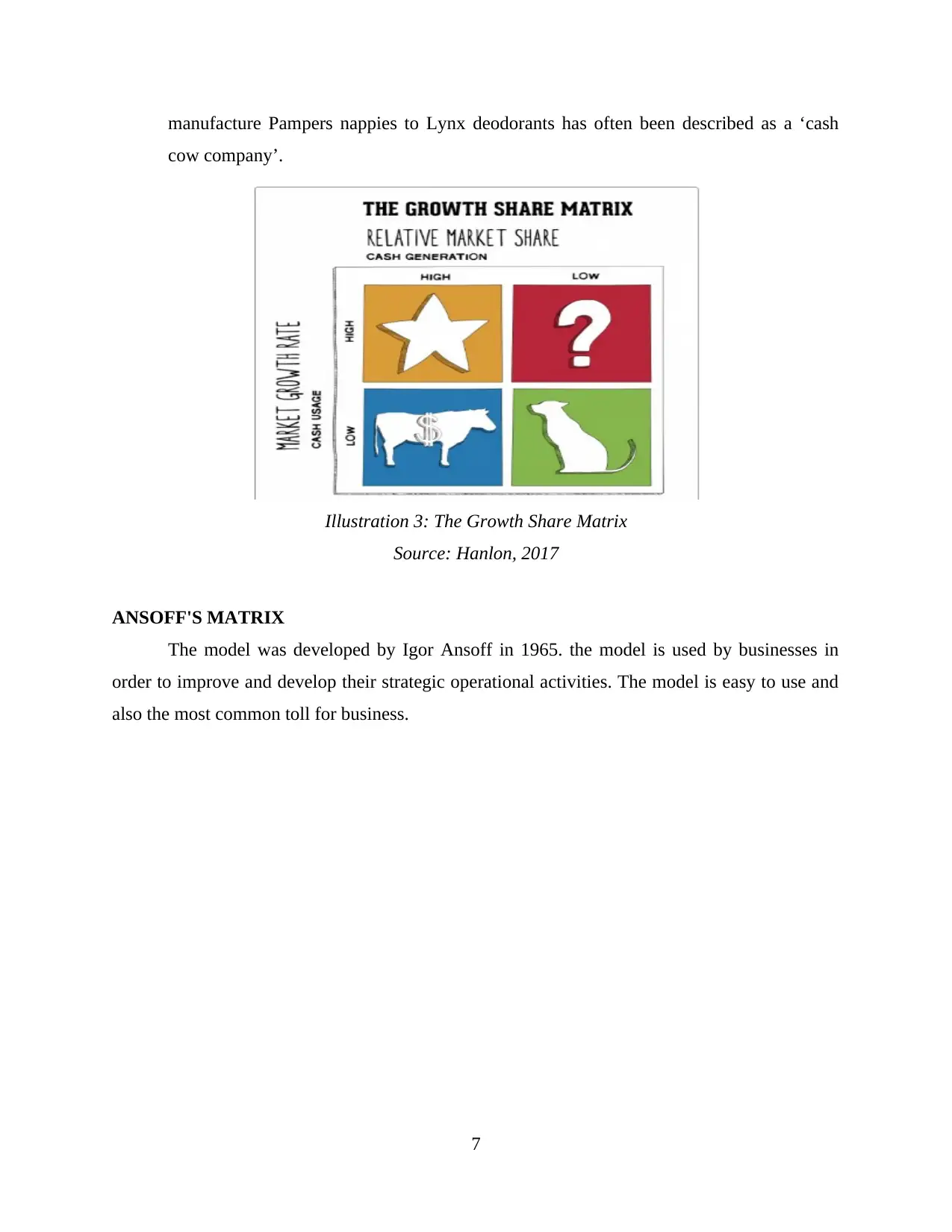
manufacture Pampers nappies to Lynx deodorants has often been described as a ‘cash
cow company’.
ANSOFF'S MATRIX
The model was developed by Igor Ansoff in 1965. the model is used by businesses in
order to improve and develop their strategic operational activities. The model is easy to use and
also the most common toll for business.
7
Illustration 3: The Growth Share Matrix
Source: Hanlon, 2017
cow company’.
ANSOFF'S MATRIX
The model was developed by Igor Ansoff in 1965. the model is used by businesses in
order to improve and develop their strategic operational activities. The model is easy to use and
also the most common toll for business.
7
Illustration 3: The Growth Share Matrix
Source: Hanlon, 2017
⊘ This is a preview!⊘
Do you want full access?
Subscribe today to unlock all pages.

Trusted by 1+ million students worldwide
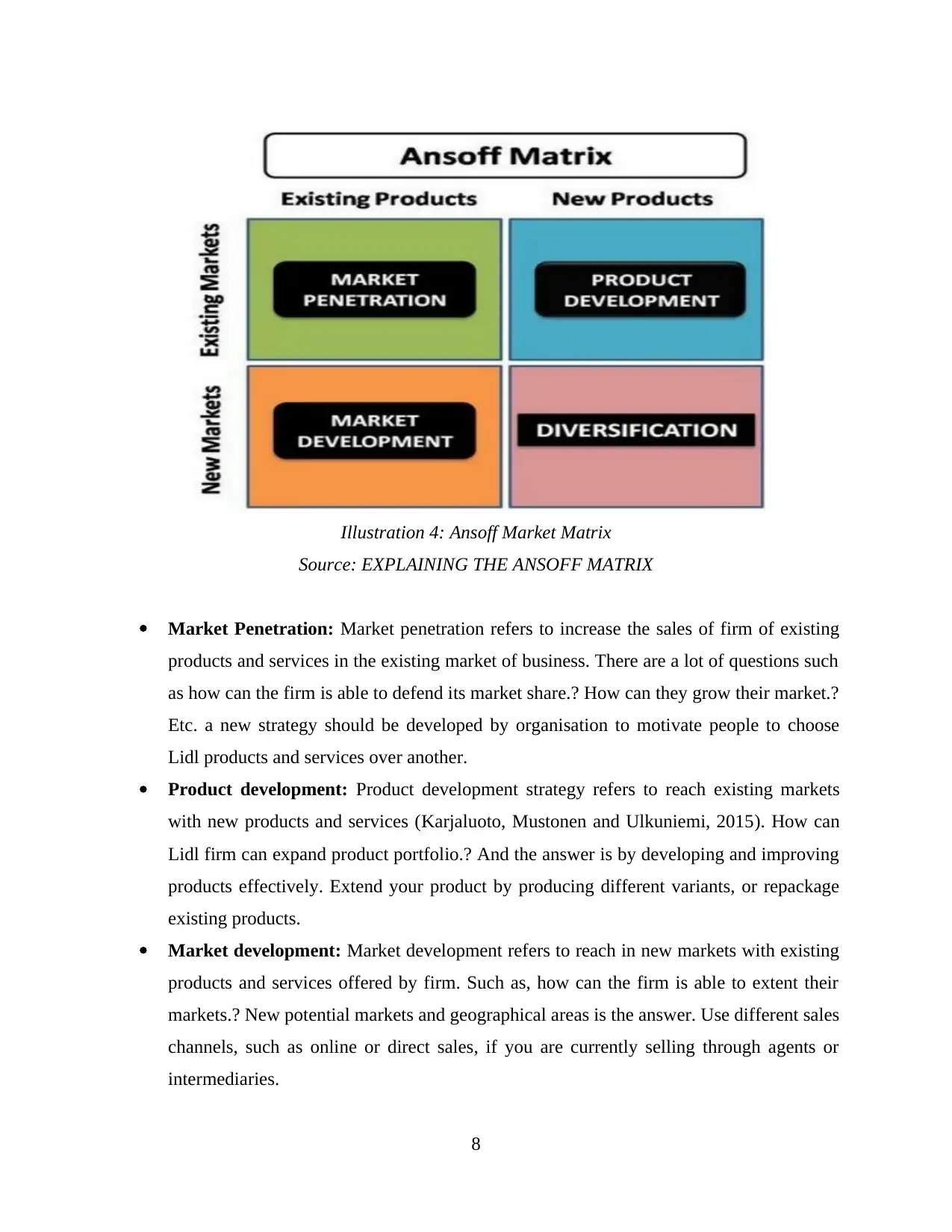
Market Penetration: Market penetration refers to increase the sales of firm of existing
products and services in the existing market of business. There are a lot of questions such
as how can the firm is able to defend its market share.? How can they grow their market.?
Etc. a new strategy should be developed by organisation to motivate people to choose
Lidl products and services over another.
Product development: Product development strategy refers to reach existing markets
with new products and services (Karjaluoto, Mustonen and Ulkuniemi, 2015). How can
Lidl firm can expand product portfolio.? And the answer is by developing and improving
products effectively. Extend your product by producing different variants, or repackage
existing products.
Market development: Market development refers to reach in new markets with existing
products and services offered by firm. Such as, how can the firm is able to extent their
markets.? New potential markets and geographical areas is the answer. Use different sales
channels, such as online or direct sales, if you are currently selling through agents or
intermediaries.
8
Illustration 4: Ansoff Market Matrix
Source: EXPLAINING THE ANSOFF MATRIX
products and services in the existing market of business. There are a lot of questions such
as how can the firm is able to defend its market share.? How can they grow their market.?
Etc. a new strategy should be developed by organisation to motivate people to choose
Lidl products and services over another.
Product development: Product development strategy refers to reach existing markets
with new products and services (Karjaluoto, Mustonen and Ulkuniemi, 2015). How can
Lidl firm can expand product portfolio.? And the answer is by developing and improving
products effectively. Extend your product by producing different variants, or repackage
existing products.
Market development: Market development refers to reach in new markets with existing
products and services offered by firm. Such as, how can the firm is able to extent their
markets.? New potential markets and geographical areas is the answer. Use different sales
channels, such as online or direct sales, if you are currently selling through agents or
intermediaries.
8
Illustration 4: Ansoff Market Matrix
Source: EXPLAINING THE ANSOFF MATRIX
Paraphrase This Document
Need a fresh take? Get an instant paraphrase of this document with our AI Paraphraser
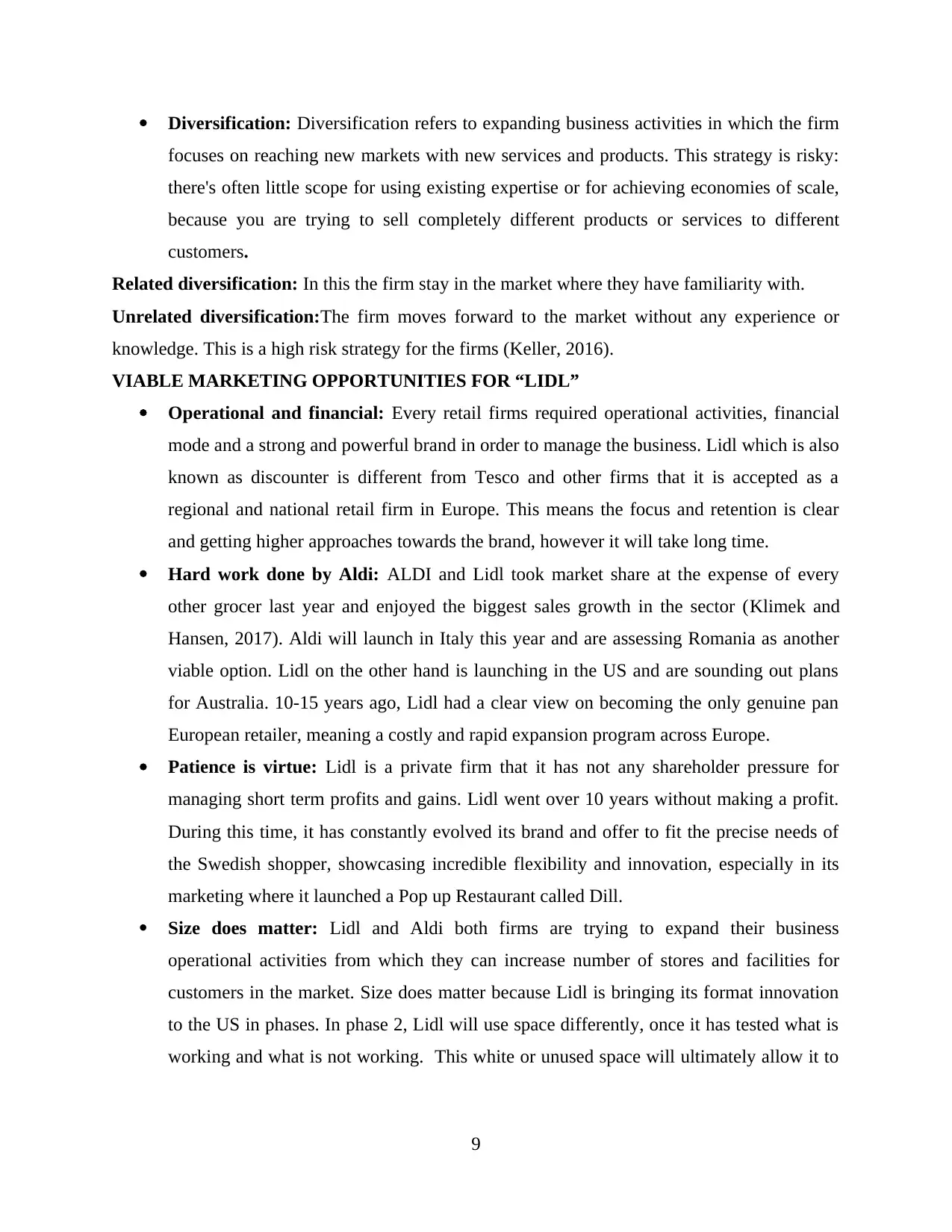
Diversification: Diversification refers to expanding business activities in which the firm
focuses on reaching new markets with new services and products. This strategy is risky:
there's often little scope for using existing expertise or for achieving economies of scale,
because you are trying to sell completely different products or services to different
customers.
Related diversification: In this the firm stay in the market where they have familiarity with.
Unrelated diversification:The firm moves forward to the market without any experience or
knowledge. This is a high risk strategy for the firms (Keller, 2016).
VIABLE MARKETING OPPORTUNITIES FOR “LIDL”
Operational and financial: Every retail firms required operational activities, financial
mode and a strong and powerful brand in order to manage the business. Lidl which is also
known as discounter is different from Tesco and other firms that it is accepted as a
regional and national retail firm in Europe. This means the focus and retention is clear
and getting higher approaches towards the brand, however it will take long time.
Hard work done by Aldi: ALDI and Lidl took market share at the expense of every
other grocer last year and enjoyed the biggest sales growth in the sector (Klimek and
Hansen, 2017). Aldi will launch in Italy this year and are assessing Romania as another
viable option. Lidl on the other hand is launching in the US and are sounding out plans
for Australia. 10-15 years ago, Lidl had a clear view on becoming the only genuine pan
European retailer, meaning a costly and rapid expansion program across Europe.
Patience is virtue: Lidl is a private firm that it has not any shareholder pressure for
managing short term profits and gains. Lidl went over 10 years without making a profit.
During this time, it has constantly evolved its brand and offer to fit the precise needs of
the Swedish shopper, showcasing incredible flexibility and innovation, especially in its
marketing where it launched a Pop up Restaurant called Dill.
Size does matter: Lidl and Aldi both firms are trying to expand their business
operational activities from which they can increase number of stores and facilities for
customers in the market. Size does matter because Lidl is bringing its format innovation
to the US in phases. In phase 2, Lidl will use space differently, once it has tested what is
working and what is not working. This white or unused space will ultimately allow it to
9
focuses on reaching new markets with new services and products. This strategy is risky:
there's often little scope for using existing expertise or for achieving economies of scale,
because you are trying to sell completely different products or services to different
customers.
Related diversification: In this the firm stay in the market where they have familiarity with.
Unrelated diversification:The firm moves forward to the market without any experience or
knowledge. This is a high risk strategy for the firms (Keller, 2016).
VIABLE MARKETING OPPORTUNITIES FOR “LIDL”
Operational and financial: Every retail firms required operational activities, financial
mode and a strong and powerful brand in order to manage the business. Lidl which is also
known as discounter is different from Tesco and other firms that it is accepted as a
regional and national retail firm in Europe. This means the focus and retention is clear
and getting higher approaches towards the brand, however it will take long time.
Hard work done by Aldi: ALDI and Lidl took market share at the expense of every
other grocer last year and enjoyed the biggest sales growth in the sector (Klimek and
Hansen, 2017). Aldi will launch in Italy this year and are assessing Romania as another
viable option. Lidl on the other hand is launching in the US and are sounding out plans
for Australia. 10-15 years ago, Lidl had a clear view on becoming the only genuine pan
European retailer, meaning a costly and rapid expansion program across Europe.
Patience is virtue: Lidl is a private firm that it has not any shareholder pressure for
managing short term profits and gains. Lidl went over 10 years without making a profit.
During this time, it has constantly evolved its brand and offer to fit the precise needs of
the Swedish shopper, showcasing incredible flexibility and innovation, especially in its
marketing where it launched a Pop up Restaurant called Dill.
Size does matter: Lidl and Aldi both firms are trying to expand their business
operational activities from which they can increase number of stores and facilities for
customers in the market. Size does matter because Lidl is bringing its format innovation
to the US in phases. In phase 2, Lidl will use space differently, once it has tested what is
working and what is not working. This white or unused space will ultimately allow it to
9
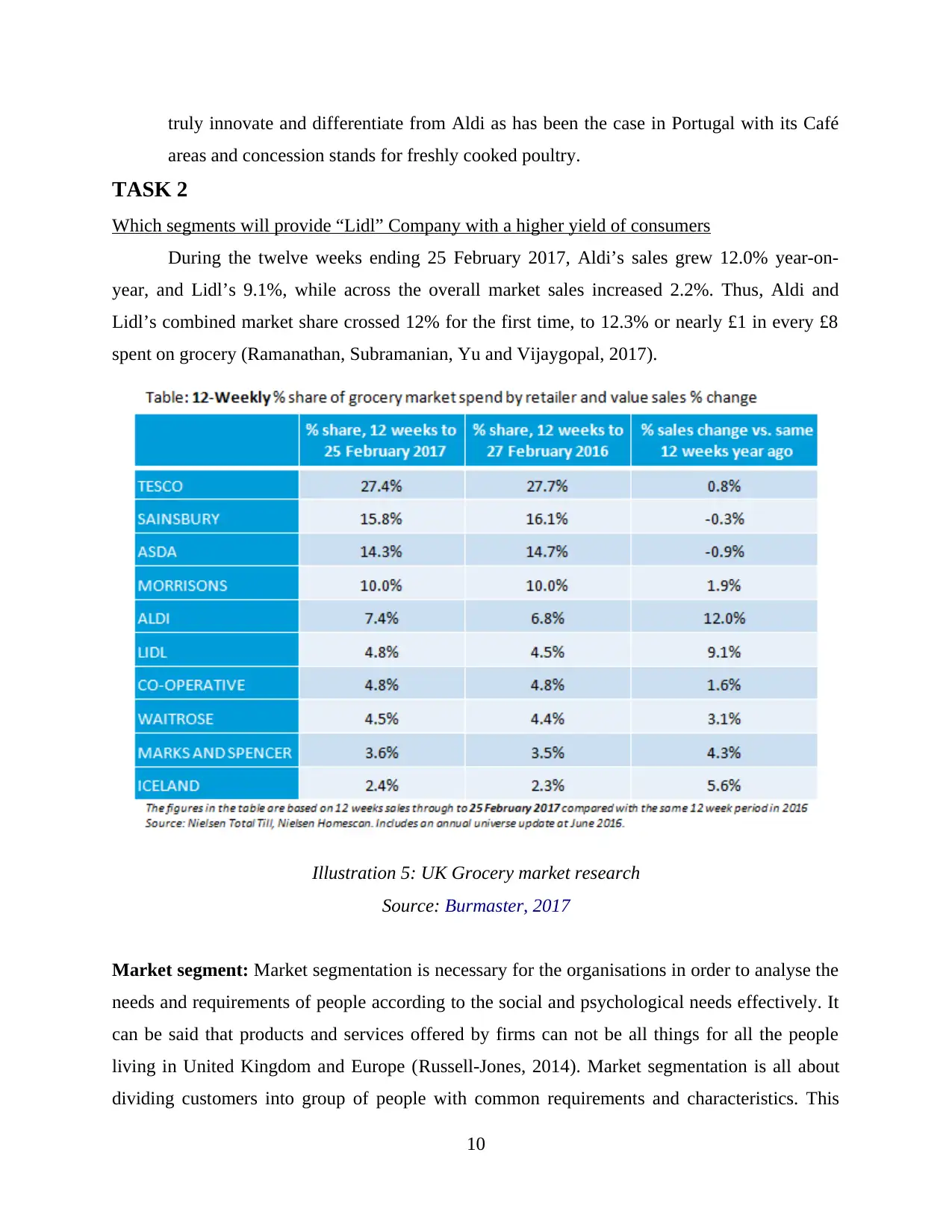
truly innovate and differentiate from Aldi as has been the case in Portugal with its Café
areas and concession stands for freshly cooked poultry.
TASK 2
Which segments will provide “Lidl” Company with a higher yield of consumers
During the twelve weeks ending 25 February 2017, Aldi’s sales grew 12.0% year-on-
year, and Lidl’s 9.1%, while across the overall market sales increased 2.2%. Thus, Aldi and
Lidl’s combined market share crossed 12% for the first time, to 12.3% or nearly £1 in every £8
spent on grocery (Ramanathan, Subramanian, Yu and Vijaygopal, 2017).
Market segment: Market segmentation is necessary for the organisations in order to analyse the
needs and requirements of people according to the social and psychological needs effectively. It
can be said that products and services offered by firms can not be all things for all the people
living in United Kingdom and Europe (Russell-Jones, 2014). Market segmentation is all about
dividing customers into group of people with common requirements and characteristics. This
10
Illustration 5: UK Grocery market research
Source: Burmaster, 2017
areas and concession stands for freshly cooked poultry.
TASK 2
Which segments will provide “Lidl” Company with a higher yield of consumers
During the twelve weeks ending 25 February 2017, Aldi’s sales grew 12.0% year-on-
year, and Lidl’s 9.1%, while across the overall market sales increased 2.2%. Thus, Aldi and
Lidl’s combined market share crossed 12% for the first time, to 12.3% or nearly £1 in every £8
spent on grocery (Ramanathan, Subramanian, Yu and Vijaygopal, 2017).
Market segment: Market segmentation is necessary for the organisations in order to analyse the
needs and requirements of people according to the social and psychological needs effectively. It
can be said that products and services offered by firms can not be all things for all the people
living in United Kingdom and Europe (Russell-Jones, 2014). Market segmentation is all about
dividing customers into group of people with common requirements and characteristics. This
10
Illustration 5: UK Grocery market research
Source: Burmaster, 2017
⊘ This is a preview!⊘
Do you want full access?
Subscribe today to unlock all pages.

Trusted by 1+ million students worldwide
1 out of 22
Related Documents
Your All-in-One AI-Powered Toolkit for Academic Success.
+13062052269
info@desklib.com
Available 24*7 on WhatsApp / Email
![[object Object]](/_next/static/media/star-bottom.7253800d.svg)
Unlock your academic potential
Copyright © 2020–2025 A2Z Services. All Rights Reserved. Developed and managed by ZUCOL.





